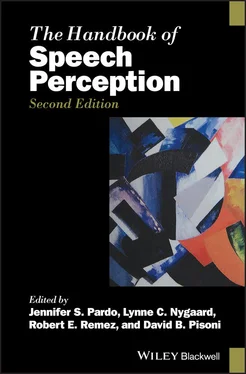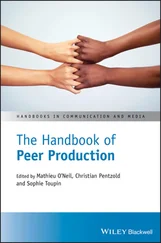24 Cynx, J., & von Rad, U. (2001). Immediate and transitory effects of delayed auditory feedback on bird song production. Animal Behaviour, 62(2), 305–312.
25 de Boysson‐Bardies, B., Sagart, L., & Durand, C. (1984). Discernible differences in the babbling of infants according to target language. Journal of Child Language, 11(1), 1–15.
26 de Boysson‐Bardies, B., & Vihman, M. M. (1991). Adaptation to language: Evidence from babbling and first words in four languages. Language, 67(2), 297–319.
27 Dell, G. S., & Chang, F. (2014). The P‐chain: Relating sentence production and its disorders to comprehension and acquisition. Philosophical Transactions of the Royal Society B: Biological Sciences, 369(1634), 20120394.
28 DePaolis, R. A., Vihman, M. M., & Keren‐Portnoy, T. (2011). Do production patterns influence the processing of speech in prelinguistic infants? Infant Behavior & Development, 34(4), 590–601.
29 Dhawale, A. K., Smith, M., & Ölveczky, B. (2017). The role of variability in motor learning. Annual Review of Neuroscience, 40, 479–498.
30 Eliades, S. J., & Wang, X. (2003). Sensory‐motor interaction in the primate auditory cortex during self‐initiated vocalizations. Journal of Neurophysiology, 89(4), 2194–2207.
31 Eliades, S. J., & Wang, X. (2008). Neural substrates of vocalization feedback monitoring in primate auditory cortex. Nature, 453(7198), 1102–1106.
32 Fox, R. A. (1982). Individual variation in the perception of vowels: Implications for a perception–production link. Phonetica, 39(1), 1–22.
33 Franken, M. K., Acheson, D. J., McQueen, J. M., et al. (2017). Individual variability as a window on production–perception interactions in speech motor control. Journal of the Acoustical Society of America, 142(4), 2007–2018.
34 Franken, M. K., Acheson, D. J., McQueen, J. M., et al. (2018). Opposing and following responses in sensorimotor speech control: Why responses go both ways. Psychonomic Bulletin & Review, 25(4), 1458–1467.
35 Frieda, E. M., Walley, A. C., Flege, J. E., & Sloane, M. E. (2000). Adults’ perception and production of the English vowel /i/. Journal of Speech, Language, and Hearing Research, 43(1), 129–143.
36 Garrod, S., & Pickering, M. J. (2004). Why is conversation so easy?. Trends in cognitive sciences, 8(1), 8–11.
37 Griffiths, T. L., Lieder, F., & Goodman, N. D. (2015). Rational use of cognitive resources: Levels of analysis between the computational and the algorithmic. Topics in Cognitive Science, 7(2), 217–229.
38 Guenther, F. H. (1995). Speech sound acquisition, coarticulation, and rate effects in a neural network model of speech production. Psychological Review, 102(3), 594–621.
39 Guenther, F. H. (2016). Neural control of speech. Cambridge, MA: MIT Press.
40 Guenther, F. H., Ghosh, S. S., & Tourville, J. A. (2006). Neural modeling and imaging of the cortical interactions underlying syllable production. Brain and Language, 96(3), 280–301.
41 Guenther, F. H., & Hickok, G. (2015). Role of the auditory system in speech production. In M. J. Aminoff, F. Boller, & D. F. Swaab (Eds), Handbook of clinical neurology: Vol. 129. The human auditory system: Fundamental organization and clinical disorders (pp. 16–175). Amsterdam: Elsevier.
42 Harris, C. & Wolpert, D. (1998). Signal‐dependent noise determines motor planning. Nature, 394, 780–784.
43 Hashimoto, Y., & Sakai, K. L. (2003). Brain activations during conscious self‐monitoring of speech production with delayed auditory feedback: An fMRI study. Human Brain Mapping, 20(1), 22–28.
44 Heinks‐Maldonado, T. H., Mathalon, D. H., Gray, M., & Ford, J. M. (2005). Fine‐tuning of auditory cortex during speech production. Psychophysiology, 42(2), 180–190.
45 Hickok, G. (2012). Computational neuroanatomy of speech production. Nature Reviews Neuroscience, 13(2), 135–145.
46 Hickok, G. (2014). The myth of mirror neurons: The real neuroscience of communication and cognition. New York: W. W. Norton.
47 Hickok, G., Holt, L. L., & Lotto, A. J. (2009). Response to Wilson: What does motor cortex contribute to speech perception? Trends in Cognitive Sciences, 13(8), 330–331.
48 Houde, J. F., & Chang, E. F. (2015). The cortical computations underlying feedback control in vocal production. Current Opinion in Neurobiology, 33, 174–181.
49 Houde, J. F., & Jordan, M. I. (1998). Sensorimotor adaptation in speech production. Science, 279(5354), 1213–1216.
50 Houde, J. F., & Nagarajan, S. S. (2011). Speech production as state feedback control. Frontiers in Human Neuroscience, 5, 82.
51 Houde, J. F., Nagarajan, S. S., Sekihara, K., & Merzenich, M. M. (2002). Modulation of the auditory cortex during speech: an MEG study. Journal of Cognitive Neuroscience, 14(8), 1125–1138.
52 Howard, I. S., & Messum, P. (2011). Modeling the development of pronunciation in infant speech acquisition. Motor Control, 15(1), 85–117.
53 Howard, I. S., & Messum, P. (2014). Learning to pronounce first words in three languages: An investigation of caregiver and infant behavior using a computational model of an infant. PLOS One, 9(10), e110334.
54 Huizenga, T. (2016). Killing me sharply with her song”: The improbable story of Florence Foster Jenkins. NPR, August 10. Retrieved August 4, 2020, from www.npr.org/sections/deceptivecadence/2016/08/10/488724807/killing‐me‐sharply‐with‐her‐song‐the‐improbable‐story‐of‐florence‐foster‐jenkins.
55 Jones, P. D., & Holding, D. H. (1975). Extremely long‐term persistence of the McCollough effect. Journal of Experimental Psychology: Human Perception and Performance, 1(4), 323–327.
56 Jones, J. A., & Keough, D. (2008). Auditory‐motor mapping for pitch control in singers and nonsingers. Experimental Brain Research, 190(3), 279–287.
57 Kawato, M. (1990) Computational schemes and neural network models for formation and control of multijoint arm trajectory. In W. T. Miller III, R. S. Sutton, & P. J. Werbos (Eds.), Neural networks for control (pp. 197–228). Cambridge, MA: MIT Press.
58 Kern, S., Davis, B., & Zink, I. (2009). From babbling to first words in four languages. In F. d’Errico & J. M. Hombert (Eds), Becoming eloquent: Advances in the emergence of language, human cognition, and modern cultures. Philadelphia: John Benjamins.
59 Kim, M., Horton, W. S., & Bradlow, A. R. (2011). Phonetic convergence in spontaneous conversations as a function of interlocutor language distance. Laboratory Phonology, 2(1), 125–156.
60 Kittredge, A. K., & Dell, G. S. (2016). Learning to speak by listening: Transfer of phonotactics from perception to production. Journal of Memory and Language, 89, 8–22.
61 Kobayasi, K. I., & Okanoya, K. (2003). Context‐dependent song amplitude control in Bengalese finches. Neuroreport, 14(3), 521–524.
62 Lametti, D. R., Krol, S. A., Shiller, D. M., & Ostry, D. J. (2014). Brief periods of auditory perceptual training can determine the sensory targets of speech motor learning. Psychological Science, 25(7), 1325–1336.
63 Lane, H., & Webster, J. W. (1991). Speech deterioration in postlingually deafened adults. Journal of the Acoustical Society of America, 89(2), 859–866.
64 Lashley, K. S. (1951). The problem of serial order in behavior. In L. A. Jeffress (Ed.), Cerebral mechanisms in behavior (pp. 112–131). New York: Wiley.
65 Leder, S. B., Spitzer, J. B., & Kirchner, J. C. (1987). Speaking fundamental frequency of postlingually profoundly deaf adult men. Annals of Otology, Rhinology & Laryngology, 96(3), 322–324.
66 Lee, C. C., Jhang, Y., Chen, L. M., et al. (2017). Subtlety of ambient‐language effects in babbling: A study of English‐and Chinese‐learning infants at 8, 10, and 12 months. Language Learning and Development, 13(1), 100–126.
Читать дальше








![О Генри - Справочник Гименея [The Handbook of Hymen]](/books/407356/o-genri-spravochnik-gimeneya-the-handbook-of-hymen-thumb.webp)



